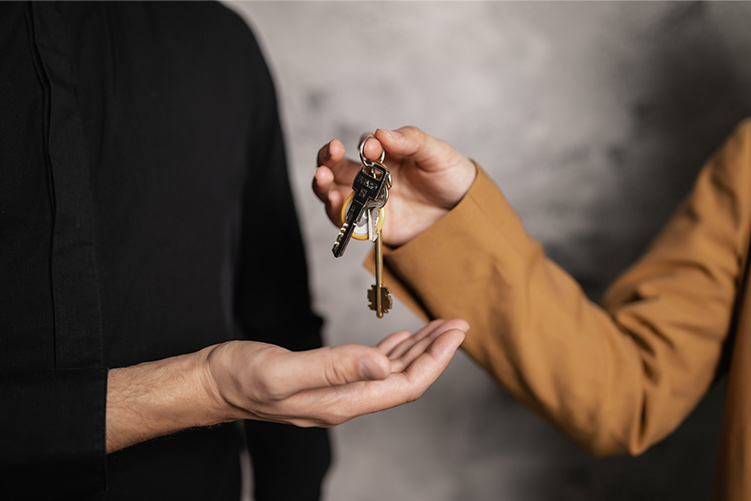Buying a home can feel overwhelming, especially if you’re a first-time homebuyer. But don’t worry, preparation is key!
This guide covers all the essential steps involved in the home-buying process, so you’ll know what to expect and be well-prepared for the journey ahead.
Get an estimate of time scales
The timeline for completing a property purchase can vary greatly as it depends on various factors such as the property type, length of the chain, personal circumstances, and the workload and availability of conveyancers.
These factors can influence the duration of the buying process and it’s important to be aware of them to manage expectations and plan accordingly.
As an example, conveyancing for a flat typically takes longer than for a house due to additional legal work involved in checking the lease and management packs.
Properties with long chains, where multiple properties are dependent on each other for completion, can also significantly prolong the process compared to chain-free properties.
It’s important to note that the timelines provided are only averages and can vary depending on the specific circumstances of each property purchase.
- Finding a property: 4 weeks – 3 months
- Conveyancing: 4-12 weeks
- Exchange of contracts to completion: 1 day – 1 month
Calculate your budget and secure an agreement in principle
When you’ve made the decision to explore buying a home, one of the first steps is to determine how much you can borrow. You’ll need to share your financial details with a mortgage broker or provider, who will assess your eligibility and provide you with information on the amount you can borrow, taking into account your deposit.
Obtaining an Agreement in Principle from a lender is a good idea, as it can give you peace of mind that you’ve been pre-approved for a mortgage and may also strengthen your negotiating position when making an offer on a property.
It’s also crucial to ensure that you estimate and budget for the costs associated with buying a home, as well as moving expenses, if applicable. This includes accounting for expenses such as stamp duty, mortgage fees, and conveyancing costs.
Viewing properties
Once you’ve established your budget, it’s time for the exciting part – finding the perfect property! It’s a good idea to register with multiple property search portals such as Rightmove, Zoopla and others.
Make sure to sign up for regular updates on new property listings and personalise your search criteria to receive relevant property recommendations. Additionally, registering with local estate agents can also be beneficial in finding suitable properties that match your requirements.
Second viewing
After finding a property you’re interested in, it’s advisable to visit it again for a second viewing to ensure it’s the right fit for you. Consider visiting at different times of the day to see how the property looks in different lighting conditions and to assess the traffic and activity in the surrounding area.
Bringing along a friend or family member for a second opinion can also be helpful. You can book a second viewing either before or after making an offer on the property, depending on your preference and the arrangement with the seller or estate agent.
Make an offer
The next step, if you’re sure about the property, is to place an offer with the seller or estate agent. Don’t commit to more than you can afford, no matter how much you like it. It’s also more often than not that your first offer will be rejected, so don’t get disheartened.
Offer accepted
Great news! Your offer has been accepted. However, there is still a long way to go. The estate agent will usually require proof of identification, details of your solicitor, and a copy of your agreement in principle, so they can cease marketing the property. It’s worth mentioning that neither the buyer nor the seller are committed to the sale at this point and can still decide not to proceed.
Chose a solicitor/ conveyancing firm
You will need to choose a solicitor to carry out the conveyancing work and provide your estate agent with these details. They will usually require funds on account to cover third-party costs, which are typically around £300-£500. Make sure to check that your solicitor is on the panel with the mortgage provider you are applying with
Find the best mortgage
You’ve already done some of the groundwork with the decision in principle, but now it’s time to research the market and choose the most suitable deal for you. This is where it’s worth considering working with a mortgage broker like Strive to help you find the best deal.
Speak To an Expert
Whether you’ve just had an offer accepted on a property and you’re ready to go, or you’re simply wondering how much you need to save for a deposit, it’s never too soon to reach out.
Apply for the mortgage
Once you or a broker has sourced the most suitable deal, it’s time to apply. You’ll need to have all your paperwork in order, including ID, proof of income, proof of deposit, etc.
You may be required to pay for some fees at this point, such as mortgage valuation fees, broker fees, or arrangement fees.
Mortgage underwriting and valuation
Most mortgage lenders will instruct a valuation on the day you submit your application, although some may wait until your application has been fully approved. The underwriter will review your application, documents, and entered information to make a decision on whether to lend.
The underwriting process typically takes anywhere from a couple of days to a couple of weeks, but it can take longer. The property valuation is usually booked within a week to 10 days.
Solicitor carry’s our searches
As part of the conveyancing process, your solicitor will diligently conduct various checks on the property, including local authority checks to verify compliance with planning permissions and building regulations.
They will also conduct comprehensive drainage checks to ensure there are no issues with the property’s sewerage or drainage systems. Additionally, environmental searches will be performed to identify any potential environmental risks or contamination. These checks are vital in uncovering any legal or environmental issues that could impact the property’s value or pose risks to your investment.
Mortgage offer issued
Great news, your mortgage offer is issued once the mortgage provider has concluded all its checks and deemed the property satisfactory. Typically, the mortgage offer is valid for 6 months, and a copy will be sent to both you and your solicitor.
Book a survey
It’s now time to arrange for a survey to be conducted on the property. It’s advisable to have done some research and chosen a surveyor in advance, but now is the time to book the survey.
It’s wise to wait until your mortgage has been approved before scheduling the survey to avoid incurring unnecessary costs for a property that you may not be able to secure a mortgage on. Proper planning can help you avoid unnecessary expenses.
Here are the three types of homebuyer surveys in brief:
- Valuation Survey: This is the most basic survey and is usually required by the mortgage lender to assess the value of the property and ensure it’s worth the loan amount.
- Homebuyer’s Report: This is a more detailed survey that includes an inspection of the property’s condition, identifies any significant issues, and provides recommendations for repairs or maintenance.
- Building Survey: This is the most comprehensive survey and is suitable for older properties or those with complex structures. It provides a detailed assessment of the property’s condition, identifies any defects, and offers recommendations for repairs, maintenance, or further investigation.
Arrange your insurances
When purchasing a house, your mortgage lender will likely require you to have building insurance, which covers the structure of the property.
However, if you’re buying a flat, building insurance may not be a requirement, but you will need contents insurance to cover your personal belongings.
This is an opportune time to consider other types of insurance, such as life insurance, critical illness insurance, and income protection insurance, to safeguard yourself and your family against unforeseen events that could impact your financial well-being. It’s important to carefully assess your insurance needs and seek professional advice if needed.
Agree on a completion date
Once your solicitor has completed most of the conveyancing process, it’s time to agree on a completion date. This is the date when all parties in the property chain, including buyers, sellers, and other parties involved, agree to move.
It’s crucial for all parties to coordinate and align their completion dates to avoid delays or disruptions in the process. Your solicitor will work with all parties involved to ensure a mutually agreed-upon completion date is set and all necessary arrangements are made for a smooth transfer of ownership on that date.
Transfer your deposit to your solicitor
It’s important to send your deposit money to your solicitor in preparation for the exchange of contracts. Be sure to allow plenty of time, as many banks have limits on the amount you can send in one transaction. Your solicitor will provide you with instructions on how to transfer the deposit securely,
Exchange of contracts
On exchange for contracts, both parties legally commit to the sale/purchase. The completion date is set, and a deposit is paid. It’s crucial to have buildings insurance in place at this point, as the property is now legally your responsibility.
It’s important to ensure that your buildings insurance is set up and active before the exchange of contracts to protect your investment in case of any unforeseen events.
Receive a completion statement
When you receive a solicitor’s completion statement, it outlines the final costs and fees associated with the property transaction, including legal fees, disbursements, and any outstanding balances. It provides a breakdown of the financial aspects of the completion process and the amount due for completion.
Sign the transfer deed
When you sign the transfer deed, it is a legal document that officially transfers the ownership of the property from the seller to the buyer. It is typically signed in the presence of a witness and lodged with the Land Registry to record the change of ownership.
The solicitor requests to draw down the funds
When the conveyancer draws down the funds for a purchase, they formally request the release of the mortgage funds from the lender. The time it takes for the funds to arrive can vary, typically taking a few days, but it can take up to a week depending on the processes of the lender and the banks involved.
Completion!!
On completion, the purchase transaction is finalised. The remaining balance of the purchase price, including any fees and taxes, is transferred from the buyer’s solicitor to the seller’s solicitor. Once the funds are received, the keys to the property are released to the buyer, and legal ownership of the property is transferred to the buyer.
Post completion
After completion, there are several post-completion tasks that typically take place in a property purchase:
- Payment of Stamp Duty: The buyer’s solicitor will calculate the amount of stamp duty owed based on the purchase price and other factors and arrange for its payment to the appropriate tax authority.
- Registration of Ownership: The buyer’s solicitor will submit the necessary documents to the Land Registry to register the buyer’s ownership of the property. This includes the transfer deed and other relevant documents.
- Title Deeds: The buyer’s solicitor will receive the updated title deeds from the Land Registry, which confirm the buyer’s legal ownership of the property.
For more info on how long buying a home can take, please contact a member of the Strive team, by emailing info@strivemortgages.co.uk or call us on 01273 002697.




